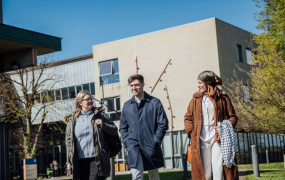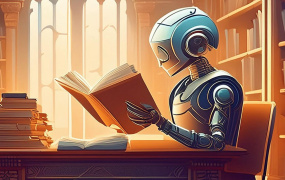Guidelines for Generative AI
The guidelines provided below are intended to help Staff at MIC understand the potential impact of Generative AI (GenAI) on academic life in a teaching context. These guidelines draw upon the advice provided by the National Academic Integrity Network (NAIN), but they have been written for the specific ethos of MIC. We hope that these guidelines will support staff as they navigate the ever-changing terrain of GenAI.
What can GenAI do?
GenAI can create written texts, produce videos, compose music, translate language, create artwork, answer maths questions, construct and explain computer code, and analyse data sets by drawing on pre-existing materials and knowledge.
What we put in to GenAI will continue to feed it as it learns from and adapts to the requests we make. However, the information that GenAI produces is not always reliable. It draws on, mimics and copies information, genres and modes from pre-existing databases, like the internet. The material it draws upon can contain biases that will shape the content produced.
GenAI has also been known to make up content and references, so the material it produces can be untrustworthy. Further, GenAI at times copies material from other sources without referencing. As such, it is not always clear whether the material produced is the content of GenAI’s creation or whether it has been lifted from another source.
Finally, we don’t always know what databases GenAI software is working from. As such, it can make use of sources that may contain things like hate speech (including but not limited to misogyny, racism, homophobia, anti-trans rhetoric, disablism/ableism, ageism, or speech that promotes violence and discrimination).
Can I just ignore GenAI?
No, GenAI is becoming embedded in much of the software we use, such as Microsoft Office and Google. For example, while we are familiar with Microsoft Word’s ability to check our spelling and grammar, the Editor function in Word now uses GenAI to make further suggestions to refine your writing. It looks at areas like clarity, conciseness, formality as well as other punctuation conventions.
GenAI is likely to impact on each of our fields in different ways. In order to understand the potential impacts, it is important that we all understand how it works and how it is evolving.
Are there any ethical concerns surrounding GenAI?
Yes, there are. When used as a tool for creation, GenAI can produce dynamic and rich material that is shaped by the user that has instructed the GenAI software. However, it is not without its ethical issues. Beyond concerns around authorship or the claim of authorship, there are concerns about those hired to screen and label content, and about how GenAI can be used to create fake content that could be hurtful to people. There are potential risks to staff and students should their own personal data or images be put into a GenAI system. The expense and infrastructure needs when running a GenAI system has led many to question whether GenAI will promote social inequality and cultural colonialism, pollute the environment, create unemployment, and enable a minority to control and manage technology and data that we use in our everyday lives.
As such, it is prudent for all staff to acquaint themselves with what GenAI is and seek to both educate and safeguard students who will be inevitably exposed to GenAI.
Does GenAI change the landscape for Academic Integrity?
Yes and no. While in more recent years staff have made use of Turnitin to identify possible notable cases of textual similarity, Turnitin has never been able to identify all cases of plagiarism. As a software, its strengths are in comparing existing digitised texts. This means that it is less likely to detect text similarity with print-only materials. It cannot identify if a piece of work was written by another person that is not the named and (digitally) published author. It often cannot identify work that comes from papermills. Without concrete evidence, we cannot identify with certainty these forms of plagiarism.
GenAI offers students a way to produce assessments quickly and for free, or at a relatively low cost, in a manner that by and large we cannot trace. However, it is not perfect. It makes up references, includes copied, unreferenced content, makes biased statements and it fabricates content. These are all areas that can be either identified as poor academic practice or as plagiarism. The possibility and temptation of academic dishonesty has always existed. GenAI simply adds to the range and ease of possibilities for academic misconduct.
Will GenAI impact all disciplines equally?
No, there are different types of GenAI that can be used in different ways in different fields. It is important that you seek to familiarise yourself with the different forms of GenAI that might relate to your discipline.
Can we lie to students to make them think we can identify GenAI?
No, we must demonstrate integrity and we need to treat students with respect. You may wish to discuss the risks and possibilities of using GenAI with your students. Students can easily establish that we cannot confidently identify GenAI, as it is well documented online and in the media. Lying to students will simply encourage them to distrust staff. Instead, we should let them know about the risks associated with using GenAI, from an academic integrity standpoint. They should be made aware that GenAI can fabricate content and references, which is deemed to be academic dishonesty within MIC’s policy on academic integrity. They should also know that GenAI may copy and use unreferenced sources in the GenAI output. If this unreferenced material is identified in their paper, they may be investigated for academic dishonesty and plagiarism.
Should I modify my assessments in response to GenAI?
You should discuss as a whole with your department if you feel that the assessments across your programme are vulnerable to GenAI. If upon reflection you are concerned about GenAI vulnerabilities in your assessments, you should consult with LEAD. We would not recommend that staff change their existing assessments independently and without consultation with their Head of Department and LEAD.
Is there anything else we can do to discourage students from using GenAI dishonestly?
Yes, we can highlight the supports and resources available to them to help them during their degree. The majority of students found plagiarising have done so in moments of panic or distress. They are often overwhelmed with personal issues such as mental health crises, health issues, crises within their family or friend groups, or because they are academically struggling. By flagging to students that supports are available to them via Student Life supports and the Academic Learning Centre, students can be helped before they feel the need to engage in academic dishonesty.
We can also work in partnership with students to create a culture of academic integrity. Remember, most students do not engage in academic dishonesty. In fact, many are concerned that other students might obtain an unfair advantage over those who are seeking to complete their degrees honestly. Higher education is a place for students to learn and develop as people. However, many of our students also rely on their Quality Credit Average to secure further work or placements as, for example, a teacher. Students consequently have a vested interest in ensuring that they are all working on an even playing field. We should not underestimate how disenfranchised students might feel if their peers obtained an unfair advantage. As such, it is pertinent that we view students as our partners in the upholding of academic integrity.
Can I encourage students to embrace GenAI?
Remember, there is still a lot we do not know or understand about GenAI. What we do know is that GenAI collects, stores and learns from all the data it is presented with, regardless of its quality, bias or reliability. The information and data collected by GenAI could produce materials that are offensive to some people or which may directly negatively impact on student lives. It is our responsibility to help students navigate this difficult terrain, but we must always have their welfare in mind.
We must be aware that we cannot control the content that is produced by GenAI and shared with students. We also cannot control how others might use their data, personal information or images on GenAI. We thus need to proceed with caution. Remember, that we do not always know where GenAI is drawing its data from or what data it has been trained on. As such, there is a possibility that things like hate speech (including but not limited to: misogyny, racism, homophobia, an-trans rhetoric, disablism/ableism, ageism, or speech that promotes violence and discrimination) could be included in the data that the GenAI is working off of. Previous GenAI experiments have notably exposed that the base attitudes and concepts that have been fed to and been learned by the technology, can shape its outputs.
What should I say to my students?
You can talk openly about the possibilities, limitations and ethical issues surrounding GenAI as it pertains to your subject area. You may wish to warn students about the potential risks for academic dishonesty that could result from using GenAI. You may also want to have them think critically about the potential risks of their own data, questions, work or images being used within GenAI.
Remind students of the supports available to them, should they feel they are struggling for any academic or personal reasons. Where possible, try to encourage them to seek help before considering taking dishonest routes.
MIC Student Support Resources
MIC Resources
National Resources
For further information on Generative AI and related topics visit the LEAD Knowledge Base.







